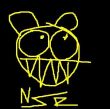| kero |
|
|
Joined: 31 Dec 2012 United States  Karma Karma: 1 
|
Pick a note on the 6th string. Let's choose the 5th fret,
for our example.
That is an A note. Ok... so what is this fancy pattern?
Down two strings, up two frets.
So skip down two strings (to the 4th string), then move up two
frets, to the 7th fret.
Now you're looking at another A. Easy, isn't it?
That holds true everywhere on the fretboard, EXCEPT when your
pattern crosses the B string. If it crosses the B string, then
you need to go up an extra fret. Careful with that.
So because the first string (high E) is the same as the 6th string
(low E), you don't need to memorize that string.
So all you really need to memorize now are the 5th and 6th
strings on your guitar, and then with this pattern, you can
very quickly figure out any note on the rest of the fretboard.
|
| kero |
|
|
Joined: 31 Dec 2012 United States  Karma Karma: 1 
|
I always knew that the 7th note on the D string was an A and that the 5th note on the E string was an A but I never thought of actually shifting that pattern somewhere else, I only used it for tuning purposes. |
| Empirism |
|
|
Joined: 23 Jun 2008 Finland  Lessons: 4 Karma: 35 
|
its a pretty cool tip actually, but I myself dun find it very useful when playin, because if say jamming lead forexample, i wish to know if any player think like this when playing..."a, c, d...cdagdca, c, d..." ;)... but ofcourse its useful to know notes on the fretboard.
-Emp |
| kero |
|
|
Joined: 31 Dec 2012 United States  Karma Karma: 1 
|
Yea, I get you but it really makes it much easier to be able to spot the notes on guitar, like know I have an advantage spotting a's b's c's etc easily on the fret board. You get me? |
| Empirism |
|
|
Joined: 23 Jun 2008 Finland  Lessons: 4 Karma: 35 
|
Yeah man, i myself mark few "key notes" on fretboard too, its very useful yeah. I used them mainly when lead changes key.
so i build lead that I can start following key pattern its root note... yeah I know, its boring but efficient :D.. |
| kero |
|
|
Joined: 31 Dec 2012 United States  Karma Karma: 1 
|
and smart!! |
| gx1327 |
|
31 Jan 2013 01:44 | Quote |
Joined: 20 Sep 2009 United States  Karma Karma: 9 
|
this is an easy way to figure out what note you are playing when you are up and close on the fretboard. for instance, everyone knows that 1st string 5th fret is A, everyone knows that 2nd string 3rd fret is C, etc. based on the frequency that chords are played there. but once you get beyond the 12th fret and up into the 4th 5th and 6th strings it's easy to lose track. so just work myself backwards and down following octaves to figure out what the note is.
and yes --- you have to compensate for the B string.
i've actually learned a few songs that use octaves in one form or another. fugazi's "public witness program", foo fighters' "everlong", weezer's "my name is jonas" are three that i know which come to mind.
so the other night i was just playing around with something with my band (wooo my band have to brag) and i was in unfamiliar territory. like i said, 14-16th fret, D B and E strings. so you can just use the octaves to work your way up or down or left or right to a familiar spot.
it also helps identify octaves across the fretboard. eventually i WILL know the notes higher up by practicing for myself.
it's smart to start with, say, the A on the 1st string 5th fret and work your way up to find all the As. off the top of my head there's also 3rd string 7th fret, then 5th string 10th fret, and then you're back on E. and of course there are more As on the other strings. 2nd string 0, 4th string 2, 6th string 5, etc. |
|
|





